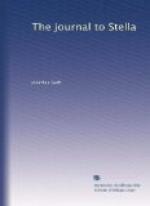10 The Countess of Jersey (see Letter 30, note 6), like her husband, was a friend of Bolingbroke’s. Lady Strafford speaks of her having lately (November 1711) “been in pickle for her sins,” at which she was not surprised. Before the Earl succeeded to the title, Lady Wentworth wrote to her son: “It’s said Lord Villors Lady was worth fower scoar thoussand pd; you might have got her, as wel as Lord Villors. . . . He [Lord Jersey) has not don well by his son, the young lady is not yoused well as I hear amongst them, which in my openion is not well.” Wentworth Papers (pp. 214, 234).
11 Cf. Letter 9, Nov. 11, 1710, and Letter 9, note 3.
12 Charles Crow, appointed Bishop of Cloyne in 1702.
13 Swift.
14 Mrs. Manley.
15 The titles of these pamphlets are as follows: (1) A True Narrative of . . . the Examination of the Marquis de Guiscard; (2) Some Remarks upon a Pamphlet entitled, A Letter to the Seven Lords; (3) A New Journey to Paris; (4) The Duke of Marlborough’s Vindication; (5) A Learned Comment on Dr. Hare’s Sermon.
16 See the pun this day above.
Letter 34.
1 See Letter 3, note 17.
2 See Letter 11, note 44.
3 Pratt (see Letter 2, note 14).
4 Stella and Dingley.
5 “Noah’s Dove, an Exhortation to Peace, set forth in a Sermon preached on the Seventh of November, 1710, a Thanksgiving Day, by Thomas Swift, A.M., formerly Chaplain to Sir William Temple, now Rector of Puttenham in Surrey.” Thomas Swift was Swift’s “little parson cousin” (see Letter 24, note 2).
6 See Letter 6, note 11. The book referred to is, apparently, An Impartial Enquiry into the Management of the War in Spain, post-dated 1712.
7 Lord Harley (afterwards second Earl of Oxford) (see Letter 5, note 35) married, on Oct. 31, 1713, Lady Henrietta Cavendish Holles, only daughter of John Holles, last Duke of Newcastle of that family (see Letter 26, note 26).
8 Bolingbroke afterwards said that the great aim (at length accomplished) of Harley’s administration was to marry his son to this young lady. Swift wrote a poetical address to Lord Harley on his marriage.
9 Thomas Pelham, first Baron Pelham, married, as his second wife, Lady Grace Holles, daughter of the Earl of Clare and sister of the Duke of Newcastle. Their eldest son, Thomas, who succeeded to the barony in 1712, was afterwards created Earl of Clare and Duke of Newcastle,
10 Francis Higgins, Rector of Baldruddery, called “the Sacheverell of Ireland,” was an extreme High Churchman, who had been charged with sedition on account of sermons preached in London in 1707. In 1711 he was again prosecuted as “a disloyal subject and disturber of the public peace.” At that time he was Prebendary of Christ Church, Dublin; in 1725 he was made Archdeacon of Cashel.
11 Swift’s pamphlet, The Conduct of the Allies.




